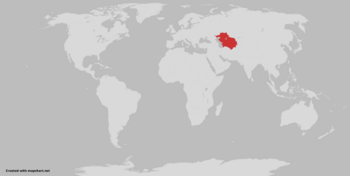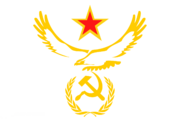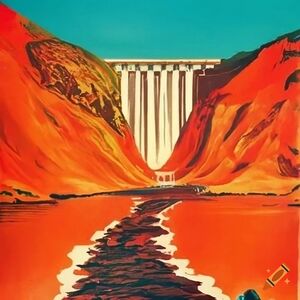Azmeny
The People’s Republic of Azmeny Azmeny | |
|---|---|
| Anthem: The Internationale | |
 A map depicting the location of Azmeny (Red) | |
| Capital | Azmenabad |
| Official languages | Azmen, Russian |
| Government | Federal Presidential Republic |
• President | Yuri Korolev |
| Legislature | Azmen National Diet |
| Establishment | 1963 (Great Patriotic Revolutionary War) |
| Area | |
• Total | 1,847,708 km2 (713,404 sq mi) |
| Population | |
• 2023 census | 80 million |
• Density | 43/km2 (111.4/sq mi) |
| GDP (nominal) | estimate |
• Total | $1.6 trillion |
• Per capita | $20,000 |
| Gini | low |
| HDI | very high |
| Currency | Az |
| Time zone | UTC+5 (Azmenabad standard time) |
| Internet TLD | .az |
This article is incomplete because it is pending further input from participants, or it is a work-in-progress by one author. Please comment on this article's talk page to share your input, comments and questions. Note: To contribute to this article, you may need to seek help from the author(s) of this page. |
Azmeny, officially the People’s Republic of Azmeny is a country in Central Asia. It is the region’s most populous country, with 80 million inhabitants. Azmeny is located on the eastern shore of the Caspian Sea, Azmeny’s capital and most populous city is Azmenabad, which is home to 9 million people. Other important cities include Pakhet, Altairny and Novostrashny which are all home to over 1 million inhabitants. Most of Azmeny’s large cities are located in the north and east of the country.
Azmeny was settled during the Paleolithic era, with Turkic people settling the region in the sixth century who became the precursors of the modern Azmen people. Russian settlement began on a large scale in the early 16th century, although many Russians can trace their origins back to 19th and early 20th century immigration. Throughout its history has been part of the Persian, Mongol and Russian empires until the foundation of the Sultanate of Azmenistan in 1642 by Omar I of Azmeny. The Peoples Republic of Azmeny, following a civil war which lasted 11 years, where Petr Azmanev and the Azmen Communist Union together with assistance from the USSR overthrew Sultan Ramazan.
Modern Azmeny is often considered a great power, with an industrialised economy focused on exports of grain, oil and gas as well as a successful IT sector. Azmeny also ranks highly for indicators of development such as life expectancy, human development index and levels of education, while experiencing relatively low levels of social and economic inequality. Azmeny is a member of the Collective Security League.
Etymology
Azmeny is named after the Azmen people, the main ethnic group of the country. The country was formerly known as Azmenistan from 1642-1963, when the name was changed following the Revolution. The name Azmenistan however is still commonly used to refer to the country before 1963.
Geography and Climate
Azmeny is located in Central Asia and features a continental climate, with high seasonal temperature variations and low precipitation. Azmeny experiences highs of 40 degrees Celsius, but winter temperatures can reach as low as -20. Much of central Azmeny is made of cold desert, with the Altair desert dominating the country’s interior. The south and southeast of Azmeny is highly mountainous, with the Red mountains forming the country’s borders.
Most of Azmeny’s large cities are in the cooler, less arid north or along the Azmen river, where water is more abundant and temperatures are less extreme. Additionally, most arable land is found in the east of the country, in the province of Cheskazan. Eastern Azmeny is also home to a large lake, the sea of Uran which used to irrigate farmland and provide a source of drinking water until it was contaminated by Azmen nuclear weapons testing during the 1980s.
History of Azmeny
Azmen History before 1642
Human settlement in Azmeny began during the Paleolithic era, with the regions first known inhabitants being the Saka peoples who settled the region during the 1st millennium BC, and settled along the banks of the Azmen river. During the 5th and 6th centuries, Azmeny fell under the Achaemenid Empire, and it remained under the influence of successive Persian states until the arrival of the Mongol Empire in 1220. Azmeny’s rulers adopted Persian culture, and the introduction of the Old Persian script led to the beginning of recorded history in Azmeny. The earliest mentions of the cities of Norabad, Altairny and Azmenabad can be found in the inscriptions on the ruins of Old Azmenabad, on the eastern fringes of Azmenabad province.
Azmeny was during this period divided into many disunited kingdoms, due to geography making central administration difficult for the ancient rulers of Azmeny. However, some cities such as Norabad, Azmenabad and Altairny grew wealthy due to the increase of east west trade along the Silk Road. Azmeny also progressively was settled by Turkic speaking settlers from the sixth century, who eventually outnumbered Persians and became the modern Azmen ethnic group. The Azmen gradually adopted Islam during the 9th century.
The country saw frequent invasions by the Mongol, Persian and Russian Empires throughout its history, contributing to the ethnic and cultural makeup of the country, but also preventing political unification. However, by the 16th century most of Azmeny fell under Russian control, following the eastward expansion of the Tsardom of Russia. Azmeny’s kingdoms were turned into vassals of the Russian empire, with local rulers being coerced. Many Northern Azmen converted to Christianity during this period due to an influx of missionaries from Russia
The Sultanate of Azmenistan (1642-1963)
The Sultanate of Azmenistan was founded by Omar I in 1642, marking the creation of the first Azmen state, emerging initially as a loose confederation of Azmen tribes and nobles run under a decentralised feudal state, with the Sultan having to rely often on the private armies of the nobility to maintain power over the vast kingdom. However, following the accession to the throne of Omar’s grandson Mahmud III in 1675, Azmenistan gradually became more centralised politically under a sprawling Persian-speaking bureaucracy and a standing army. Azmenistan’s sultans also built roads to increase the connectedness of Azmeny’s furthest provinces to the capital in Azmenabad to improve political cohesion. Azmenistan also enjoyed considerable religious tolerance, as the Sultans feared political unrest if they began to take a harder line on religion.
The 17th century saw a flourishing of Azmen culture, art and architecture as the country grew progressively wealthier, and the nobility funded lavish palaces, mosques and monuments. The Royal Court also funded artisans and musicians, especially in the country’s major towns. During this period Azmenistan’s influence in the region began to rival states such as Iran and Russia, leading to some Azmen historians calling this the ‘golden age of the Sultanate’ although this has been disputed.
By 1780 however Azmenistan had declined and gradually weakened. Successive Azmen Sultans struggled to hold onto the provinces, and powerful local rulers began to take authority from the ineffectual central government. This came at the cost of Azmeny’s military strength and political autonomy, paving the way for the exploitation of Azmenistan by the British empire during the 19th century. The Kingdom of Noristan also broke free from Azmen rule, causing the country to lose territory.
The sultanate found itself caught up in the ‘Great Game’ as both Russia and Great Britain attempted to influence Azmenistan’s foreign policy and internal politics. Of particular interest to both countries were Azmenistan’s mineral deposits, especially rumours of untapped gold reserves. Britain set up infrastructure in Azmeny, but also progressively hollowed out its internal politics, turning it into a puppet state.
Oil was discovered during the 1920s in Altairny, and the Anglo-Azmen oil company was set up in 1923, exporting oil to Britain. The business however did little to enrich the sultanate, with most profits being taken to Britain, while the country grew progressively poorer and indebted. Following the end of WW2, in which the Kingdom had sent troops to support the allied war effort, the country was close to bankrupt, and the agricultural sector in tatters due to a lack of manpower.
Azmenistan was plunged into famine, with hundred of thousands suffering from malnutrition due to the failure of harvests. Inflation soared as the government attempted to print money to pay its extravagant debts, and the government introduced a system of forced labour to rebuild the economy and to suppress discontent caused by the failure of the economy. Dissent grew against the government, which was brutally suppressed by the Sultan, Ramazan II, through the brutal Interiat, the Azmen secret police which was set up in April 1947. As dissent against the government grew, the government grew increasingly heavy-handed in its treatment of protestors.
Things came to a head in the summer of 1947 when protests at the university of Altairny were dealt with by bombing from the Azmen military. Meanwhile, underground resistance to the government grew, with the religious Pathseekers and the Azmen Communist Party becoming the main factions. Led by Petr Azmanev, the Azmen communist party grew massively in support, especially in urban areas, whereas the Pathseekers held support in rural areas.
The Great Patriotic Revolutionary War (1952-63) and the Consolidation War (1970)
On the 5th of June 1952, the Great Patriotic Revolutionary War began, with a mutiny in Novostrashny, when sailors of the Azmen Navy refused to allow the Sultan aboard their ships as part of Fleet Review. The leaders of the mutiny were executed, causing the Azmen Communist Union to organise large demonstrations, which were met with violence from the police and army. Street fighting broke out, with Azmen Communists attacking police headquarters, and storming the Sultan’s Palace on the 8th of May. The Sultan was forced to flee the country, and the Azmen Communist Union took control of the city, with popular support from the city’s workers. However, the Pathseekers fought the Communists for control, taking advantage of the instability to gain a foothold in rural areas of Azmeny.
For the next 11 years, intense fighting occurred with the Soviet Union and china supporting the Azmen Communists, whereas the Pathseekers received support from neighbouring Noristan. However, on the 8th of August 1963 Communist forces emerged triumphant, and the Pathseekers fled to Noristan. This resulted in the proclamation of the People’s Republic of Azmeny. The war resulted in the deaths of thousands of Azmen, and caused large amounts of damage to urban and rural areas of Azmen. in December 1963, Petr Azmanev became the first President of Azmeny following the first nationwide elections. Azmeny also adopted its Constitution, which declared a Presidential multiparty system, albeit with state control of the economy
Azmeny, however in the 1960s was gripped by terrorism funded by remnants of the Pathseekers who had fled to the neighbouring Kingdom of Noristan, which had opposed the communist revolution. The worst of these attacks were the 1968 National Day attacks, which killed over 850 people in central Azmenabad. Additionally, the Noristani government- seeing the People’s Republic as militarily weak- sent troops across the border to occupy multiple villages and small towns in 1969. Azmeny responded through the Consolidation War, in which Azmen soldiers entered Norabad, the capital of Noristan, in an 8-month war which both grabbed headlines and proved the efficacy of Azmeny’s army. In the ensuing years, Azmeny’s governments consequently placed a heavy emphasis on defence spending, as it attempted to suppress both monarchist rebels and the Pathseeker militia.
The ‘Grand Advance’ and Azmen Industrialisation 1970-83
From 1970, Petr Azmanev and the Ministry of Economic Planning pursued a policy of modernisation and industrialisation called Avans in Azmen and in Azmeny’s English language media referred to as the ‘Grand Advance’. This policy saw the industrialisation of Azmeny to modernise its agrarian economy, with the establishment of manufacturing and heavy industry. Infrastructure was also modernised, with the construction of motorways, modernised railways and state funded hospitals. Major national projects were constructed to increase the country’s standing and foster cohesion, including the construction of vast hydroelectric dams in Noristan.
Additionally, projects intended to advance manufacturing, such as the Avans Car, and the establishment of state agricultural machinery factories to mechanise farming. Azmeny also invested heavily in its oil production, which had been nationalised following the revolution. The aim of these reforms were to increase Azmen economic self sufficiency, as well as modernisation. Azmeny’s markets were closed to almost all imports and exports, and nearly all foreign trade came from the USSR. During this period, agriculture declined due to neglect and the exodus of people into the cities, meaning that food prices had to be kept low via subsidies.
Azmen society saw fundamental changes, as the country urbanised and its population grew. The population of Azmenabad grew by 47%, and people gained unprecedented access to healthcare, education and modernities such as running water and electricity, which before were prevalent only in urban areas. Howefer, the policy remains controversial due to the neglect of Azmen agriculture. Many also regard forced self-sufficiency as having had a detrimental impact on the Azmen economy, with a lack of many products, especially with regards to consumer goods in Azmeny.







